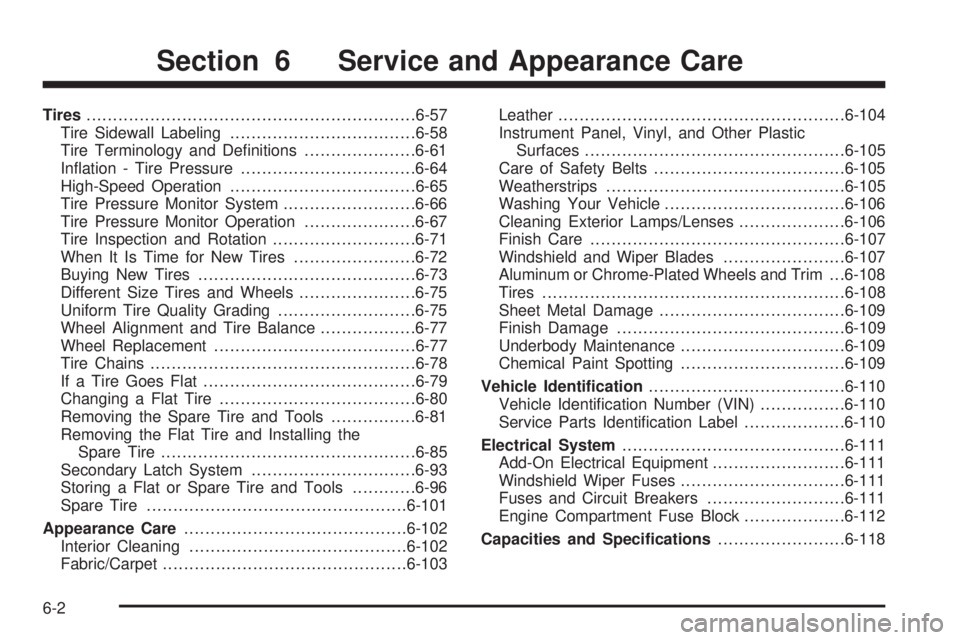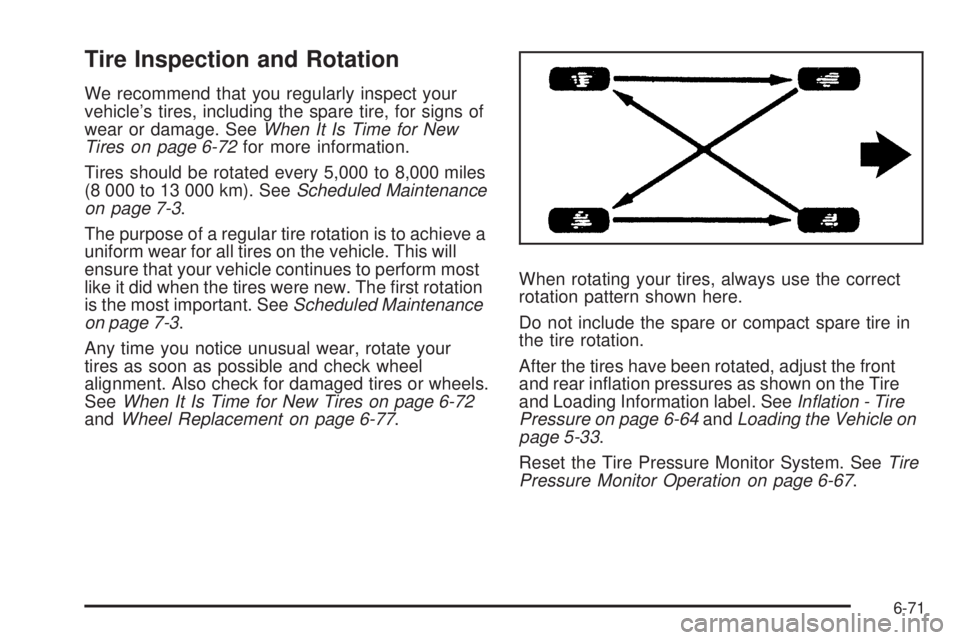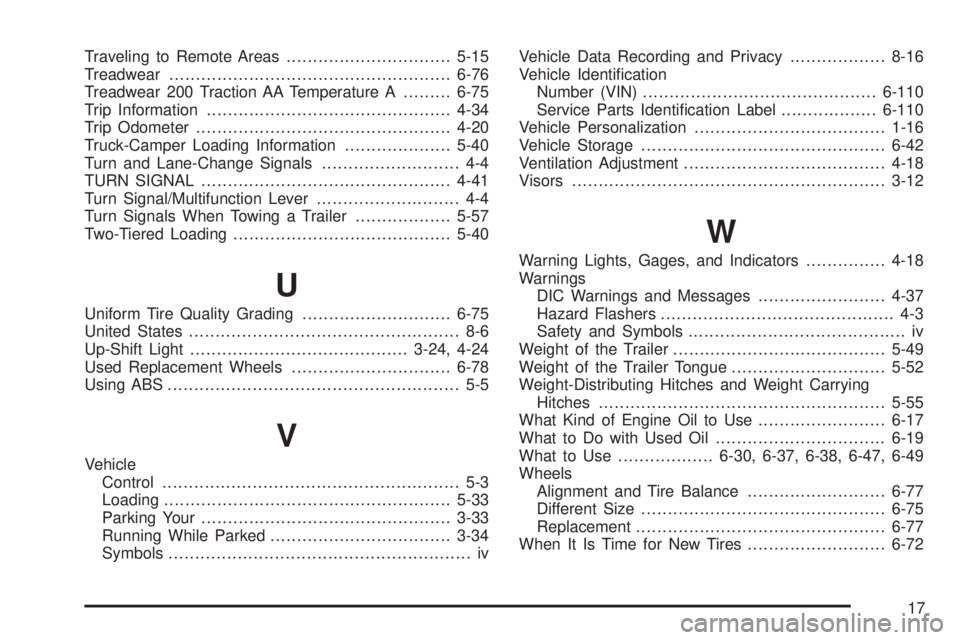2010 GMC CANYON wheel alignment
[x] Cancel search: wheel alignmentPage 278 of 448

Tires..............................................................6-57
Tire Sidewall Labeling...................................6-58
Tire Terminology and Definitions.....................6-61
Inflation - Tire Pressure.................................6-64
High-Speed Operation...................................6-65
Tire Pressure Monitor System.........................6-66
Tire Pressure Monitor Operation.....................6-67
Tire Inspection and Rotation...........................6-71
When It Is Time for New Tires.......................6-72
Buying New Tires.........................................6-73
Different Size Tires and Wheels......................6-75
Uniform Tire Quality Grading..........................6-75
Wheel Alignment and Tire Balance..................6-77
Wheel Replacement......................................6-77
Tire Chains..................................................6-78
If a Tire Goes Flat........................................6-79
Changing a Flat Tire.....................................6-80
Removing the Spare Tire and Tools................6-81
Removing the Flat Tire and Installing the
Spare Tire................................................6-85
Secondary Latch System...............................6-93
Storing a Flat or Spare Tire and Tools............6-96
Spare Tire.................................................6-101
Appearance Care..........................................6-102
Interior Cleaning.........................................6-102
Fabric/Carpet..............................................6-103Leather......................................................6-104
Instrument Panel, Vinyl, and Other Plastic
Surfaces.................................................6-105
Care of Safety Belts....................................6-105
Weatherstrips.............................................6-105
Washing Your Vehicle..................................6-106
Cleaning Exterior Lamps/Lenses....................6-106
Finish Care................................................6-107
Windshield and Wiper Blades.......................6-107
Aluminum or Chrome-Plated Wheels and Trim . . .6-108
Tires.........................................................6-108
Sheet Metal Damage...................................6-109
Finish Damage...........................................6-109
Underbody Maintenance...............................6-109
Chemical Paint Spotting...............................6-109
Vehicle Identi�cation.....................................6-110
Vehicle Identification Number (VIN)................6-110
Service Parts Identification Label...................6-110
Electrical System..........................................6-111
Add-On Electrical Equipment.........................6-111
Windshield Wiper Fuses...............................6-111
Fuses and Circuit Breakers..........................6-111
Engine Compartment Fuse Block...................6-112
Capacities and Speci�cations........................6-118
Section 6 Service and Appearance Care
6-2
Page 347 of 448

Tire Inspection and Rotation
We recommend that you regularly inspect your
vehicle’s tires, including the spare tire, for signs of
wear or damage. SeeWhen It Is Time for New
Tires on page 6-72for more information.
Tires should be rotated every 5,000 to 8,000 miles
(8 000 to 13 000 km). SeeScheduled Maintenance
on page 7-3.
The purpose of a regular tire rotation is to achieve a
uniform wear for all tires on the vehicle. This will
ensure that your vehicle continues to perform most
like it did when the tires were new. The first rotation
is the most important. SeeScheduled Maintenance
on page 7-3.
Any time you notice unusual wear, rotate your
tires as soon as possible and check wheel
alignment. Also check for damaged tires or wheels.
SeeWhen It Is Time for New Tires on page 6-72
andWheel Replacement on page 6-77.When rotating your tires, always use the correct
rotation pattern shown here.
Do not include the spare or compact spare tire in
the tire rotation.
After the tires have been rotated, adjust the front
and rear inflation pressures as shown on the Tire
and Loading Information label. SeeIn�ation - Tire
Pressure on page 6-64andLoading the Vehicle on
page 5-33.
Reset the Tire Pressure Monitor System. SeeTire
Pressure Monitor Operation on page 6-67.
6-71
Page 353 of 448

Wheel Alignment and Tire Balance
The tires and wheels on your vehicle were aligned and
balanced carefully at the factory to give you the longest
tire life and best overall performance. Adjustments to
wheel alignment and tire balancing will not be necessary
on a regular basis. However, if you notice unusual tire
wear or your vehicle pulling to one side or the other,
the alignment might need to be checked. If you notice
your vehicle vibrating when driving on a smooth road,
the tires and wheels might need to be rebalanced.
See your dealer/retailer for proper diagnosis.
Wheel Replacement
Replace any wheel that is bent, cracked, or badly rusted
or corroded. If wheel nuts keep coming loose, the wheel,
wheel bolts, and wheel nuts should be replaced. If the
wheel leaks air, replace it (except some aluminum
wheels, which can sometimes be repaired). See your
dealer/retailer if any of these conditions exist.
Your dealer/retailer will know the kind of wheel
you need.
Each new wheel should have the same load-carrying
capacity, diameter, width, offset, and be mounted
the same way as the one it replaces.If you need to replace any of your wheels, wheel bolts,
wheel nuts, or Tire Pressure Monitor System (TPMS)
sensors, replace them only with new GM original
equipment parts. This way, you will be sure to have the
right wheel, wheel bolts, wheel nuts, and TPMS sensors
for your vehicle.
{WARNING:
Using the wrong replacement wheels, wheel bolts,
or wheel nuts on your vehicle can be dangerous.
It could affect the braking and handling of your
vehicle, make your tires lose air and make you
lose control. You could have a collision in which
you or others could be injured. Always use the
correct wheel, wheel bolts, and wheel nuts for
replacement.
Notice:The wrong wheel can also cause problems
with bearing life, brake cooling, speedometer or
odometer calibration, headlamp aim, bumper height,
vehicle ground clearance, and tire or tire chain
clearance to the body and chassis.
SeeChanging a Flat Tire on page 6-80for more
information.
6-77
Page 446 of 448

Tires (cont.)
Changing a Flat Tire....................................6-80
Cleaning...................................................6-108
Different Size..............................................6-75
High-Speed Operation..................................6-65
If a Tire Goes Flat.......................................6-79
Inflation - Tire Pressure................................6-64
Inspection and Rotation................................6-71
Installing the Spare Tire................................6-85
Pressure Light.............................................4-28
Pressure Monitor Operation...........................6-67
Pressure Monitor System..............................6-66
Removing the Flat Tire.................................6-85
Removing the Spare Tire and Tools...............6-81
Secondary Latch System..............................6-93
Sidewall Labeling.........................................6-58
Spare Tire................................................6-101
Storing a Flat or Spare Tire and Tools............6-96
Terminology and Definitions...........................6-61
Uniform Tire Quality Grading.........................6-75
Wheel Alignment and Tire Balance.................6-77
Wheel Replacement.....................................6-77
When It Is Time for New Tires......................6-72
To Use the Engine Coolant Heater....................3-20
Torque Lock (Automatic Transmission)...............3-32
Total Weight on the Vehicle’s Tires....................5-54Towing
Recreational Vehicle.....................................5-41
Towing a Trailer..........................................5-48
Trailer Recommendations..............................5-60
Your Vehicle...............................................5-41
TPMS Malfunction Light and Message...............6-68
TPMS Sensor Matching Process.......................6-69
TRAC (Traction) OFF......................................4-41
Traction
Control System (TCS).................................... 5-8
Limited-Slip Rear Axle.................................... 5-9
StabiliTrak®System....................................... 5-6
TRACTION FAULT ..........................................4-41
Traction – AA, A, B, C.....................................6-76
Trailer
Towing Recommendations.............................5-60
Trailer Brakes.................................................5-55
Trailer Wiring Harness.....................................5-60
Transfer Case................................................6-48
Transmission
Fluid, Automatic...........................................6-21
Fluid, Manual..............................................6-25
Transmission Operation, Automatic....................3-21
Transmission Operation, Manual........................3-23
Transportation Options.....................................8-10
Transportation Program, Courtesy......................8-10
16
Page 447 of 448

Traveling to Remote Areas...............................5-15
Treadwear.....................................................6-76
Treadwear 200 Traction AA Temperature A.........6-75
Trip Information..............................................4-34
Trip Odometer................................................4-20
Truck-Camper Loading Information....................5-40
Turn and Lane-Change Signals.......................... 4-4
TURN SIGNAL ...............................................4-41
Turn Signal/Multifunction Lever........................... 4-4
Turn Signals When Towing a Trailer..................5-57
Two-Tiered Loading.........................................5-40
U
Uniform Tire Quality Grading............................6-75
United States................................................... 8-6
Up-Shift Light.........................................3-24, 4-24
Used Replacement Wheels..............................6-78
Using ABS....................................................... 5-5
V
Vehicle
Control........................................................ 5-3
Loading......................................................5-33
Parking Your...............................................3-33
Running While Parked..................................3-34
Symbols......................................................... ivVehicle Data Recording and Privacy..................8-16
Vehicle Identification
Number (VIN)............................................6-110
Service Parts Identification Label..................6-110
Vehicle Personalization....................................1-16
Vehicle Storage..............................................6-42
Ventilation Adjustment......................................4-18
Visors...........................................................3-12
W
Warning Lights, Gages, and Indicators...............4-18
Warnings
DIC Warnings and Messages........................4-37
Hazard Flashers............................................ 4-3
Safety and Symbols......................................... iv
Weight of the Trailer........................................5-49
Weight of the Trailer Tongue.............................5-52
Weight-Distributing Hitches and Weight Carrying
Hitches......................................................5-55
What Kind of Engine Oil to Use........................6-17
What to Do with Used Oil ................................6-19
What to Use ..................6-30, 6-37, 6-38, 6-47, 6-49
Wheels
Alignment and Tire Balance..........................6-77
Different Size..............................................6-75
Replacement...............................................6-77
When It Is Time for New Tires..........................6-72
17